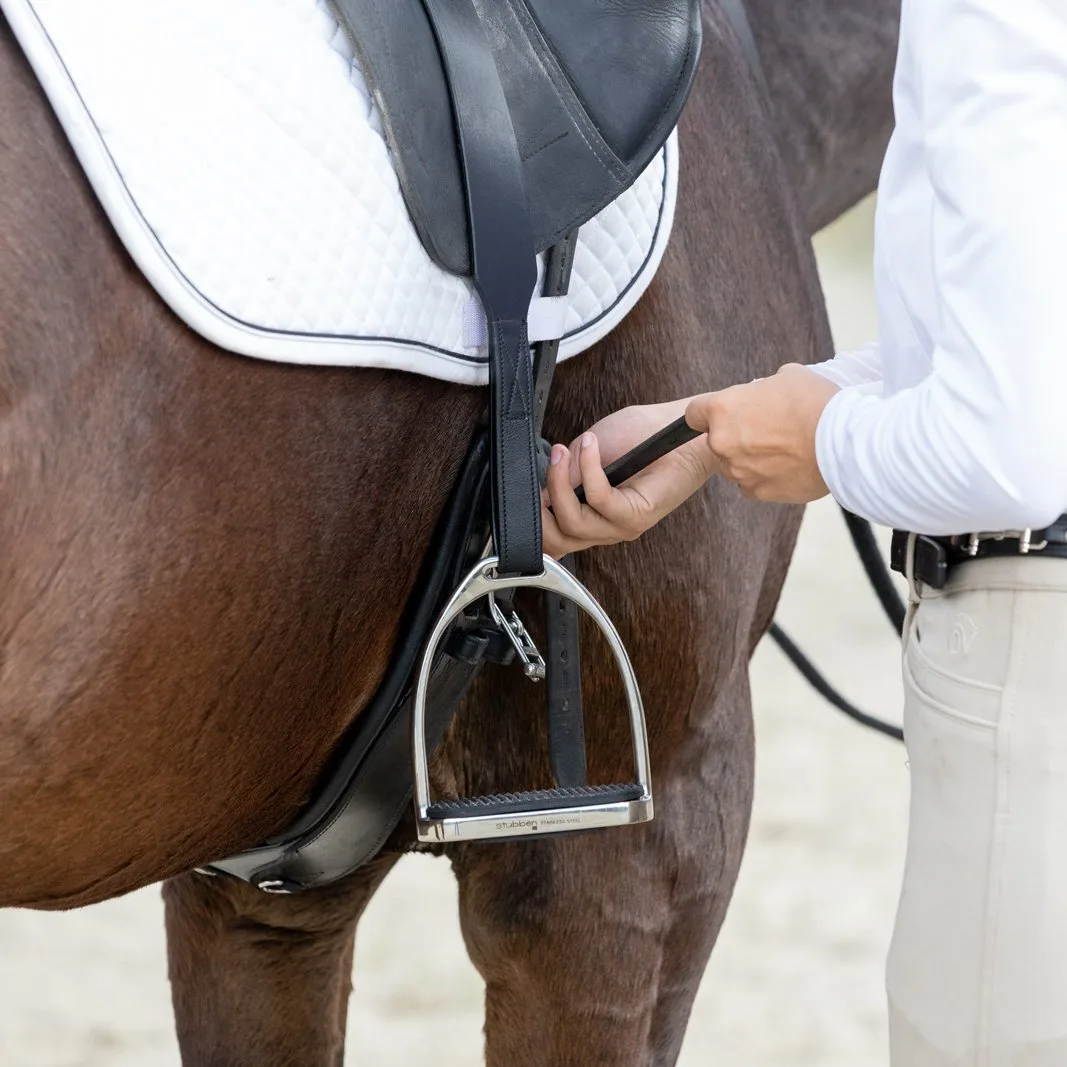Horseback riding has a language of its own. Two statements that commonly cause confusion for new riders are “tacking up” and “untacking a horse.” These phrases are used by horse owners and riders in the English and Western riding disciplines all the time and are often the first jargon to confuse new riders.
In this article I give a simple explanation of: what it means to tack up a horse, just what “tack” is, plus the basic steps to tacking up a horse.
What it Means to Tack Up a Horse
Tacking up a horse means placing a saddle, bridle, and other equipment on a horse and ensuring that each piece of equipment is secured properly.
Tacking up is a phrase that often raises eyebrows for new riders. In this phrase, tack refers to the saddlery and equipment that the horse needs to be ridden. Up refers to taking the “tack” from the “tack room” and placing the equipment on the horse properly. Next, we’ll unpack these terms.

Let’s Unpack These Terms:
Tack up – to put saddle and bridle on horse (present tense: “tacking up,” and past tense: “tacked up,” are acceptable tenses)
Untack – to remove saddle, bridal, and other equipment from the horse.
Tack room – a storage area for saddles, bridles, and other tack.
Tack – saddles, bridles, saddle pads, and the miscellaneous gear that an individual horse needs to be ridden.
What is tack? Tack is all the equipment- big and small – used to ride horses. It includes things like:
- saddle
- saddle pad
- martingale
- tie down
- girth or cinch
- bridle
- reins
- horse boots
- bridle
The definition of tack also includes items that are used to handle horses when not riding. Some examples of this type of tack are:
- lead ropes
- side reins
- lunge line
- lunging cavessons
- horse halters
- fly masks
Learning to tack up correctly is key for safe riding and part of becoming a good rider. Most riding instructors began teaching new riders to tack up a horse from the very first lesson.
Tacking up properly includes not just placing the saddle and bridle in the right places, but also:
- Fastening straps in the right places, to the right buckle.
- Ensuring that each strap and buckle is not not too tight, but not too loose either.
- And, most confusingly, avoiding unbuckling every buckle on the horses tack. (To save time, only about half of the buckles and straps are undone during tacking up and untacking)
- Using the right equipment. Not every saddle fits every horse, and using a incorrectly fit saddle can injure horses.1
Because this can be tricky to learn, most novices will not be asked to tack up a horse by themselves until they have plenty of experience.
How to Tack Up a Horse
After hearing someone refer to tacking up a horse, you might find yourself wondering exactly what this means and how to do it. Here’s a basic guide to tacking up a horse:
⚠️Be Aware: Tacking up a horse is not a simple process. Many advanced horseback riders laugh when a random character in a is able to put a saddle and bridle on a horse without instruction! Why? Because taking up a horse has many steps that require horse and rider cooperating!
Tacking up properly is essential for safety while horseback riding. If a horse’s bridle is put on incorrectly, the rider may have no control via their reins. If the saddle is put on improperly, it may slip under the horses belly- causing the rider to fall off a horse, or causing the horse to buck, bolt, or rear up.
A step-by-step guide to tacking up a horse:

How to Tack up a Horse
Total Time 15 minutes
Brush the horse
Groom the horse to remove dirt and debris that might cause uncomfortable irritation if trapped under a saddle or strap.
Place a saddle pad on the horses back
Put a blanket or padded layer on the horses back, just behind the high point of their shoulders.(This body part is called the withers in horse anatomy.)
Place a saddle on top of the saddle pad
To tack up a western horse or an English horse, the next step is to place a saddle over the saddle pad. Generally, saddles settle into place in the right place but may need adjustment by a pro.
Fasten the horse’s girth
The next important step to tack up a horse is to carefully reach under the horse to grasp the girth, bring it up to the near side of the saddle, and securely fasten the girth. Many horses will hold their breath to avoid the girth being too tight, so fastening the girth may take multiple steps. For Western writers, this step is called fastening the horses cinch.
Unbuckle the halter and place it around the horses neck
Once the saddle’s girth is snug, unbuckle the halter’s crown strap, slip it off the horses nose, and then flight the halter back around the horses neck and re-buckle it loosely. This allows you to have access to the horses face to tack them up with a bridle.
Place the bit and the horses mouth
Holding the crown of the bridle with your right hand and the bit in your left hand, flat, offer the horse the bit. Many horses will open to accept the bit, but some may need a thumb carefully inserted to lift the lips.
Slip the bridle over the horses ears gently
Being careful not to handle the ears aggressively or bump the horses eyes, slide the crown of the bridle over the horses head. The leather strap should come to rest just behind the horses ears.
Fasten the throatlatch of the bridle
To prevent the bridle from slipping back over the horses ears while you’re riding, most bridles have a throat latch. This part of tacking up involves buckling of thin strap under the horses throat. The strap does not need to be snug.
Add any additional equipment
A saddle and bridle are the essential elements of tacking up a horse for English riding and Western riding. However, many horses use additional equipment such as a breast collar, martingale, protective boots, etc.
Double check all equipment before mounting
The final step of tacking up for horse riding is – always – double checking the equipment. Do a visual inspection on both sides to be sure that the saddle pad is not folded or bunched. Make sure that both the ears are comfortably unrestricted by the bridle, and recheck the tightness of the girth.
Untacking a horse is a simpler process. To untack a horse simple do all of these things in reverse: the bridle slips off to be replaced by a halter, the saddle is removed, and the horse is brushed one final time.
Once you have learned how to do each of these steps in the list above, you will know how to tack up a horse and will be able to tack up independently whenever you need to.
Why Horse Terms like Tacking Up are so Weird
People who spend a lot of time with horses often use a lot of jargon that can be confusing to new riders. Tacking up is one of the best examples, but you will probably learn many new words your first time riding a horse. This specialized language is a combination of two things:
Tack in Context:
Equestrians have their own social circles, and any time a group of people spends time exclusively with one another communicating about a topic, specialized language will emerge – this is called jargon.
Tack in History:
The main reason that horseback riding has so many specialized terms is because horses have played such a big role in our history. Many words have fallen out of common use today that were ordinary, everyday words when transportation by horse was the most common way to get around.
It can be daunting to learn all the lingo used by those who care for and ride horses, but if you are willing to pay attention and ask questions, you can pick up the unique language of horse people very quickly.
- Harman, J. (1999). Tack and saddle fit. Veterinary Clinics of North America: Equine Practice, 15(1), 247-261. [↩]

